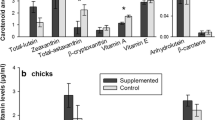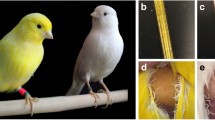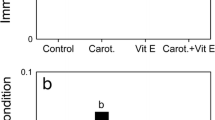Abstract
Carotenoids are widely heralded as central to honest signaling due to their dual roles as pigments and antioxidants/immunostimulants. The aim of this study is to test if diet quality and carotenoids alone or in an interaction influence condition, carotenoid availability in plasma and immune responsiveness. Therefore, a diet experiment during the moult of great tits, Parus major, was performed. In a two-way design, we manipulated general quality (digestibility, protein and vitamin content) as well as carotenoid (lutein) content of semi-synthetic diets. Higher quality diet improved individual condition since birds had greater body mass, and to a lesser extent, higher hematocrit. In addition to the expected positive effect of carotenoid supplementation and individual lutein consumption on circulating lutein, there was a positive effect of enhanced diet quality on plasma carotenoid levels. Carotenoid supplementation, but not diet quality, improved the local inflammatory response and maintenance of body mass during a humoral immune reaction. The enhancement of circulating carotenoid levels by improved general quality of the diet or individual condition could provide a testable, mechanistic explanation for the variation in effects of carotenoid supplementation studies.


Similar content being viewed by others
References
Aguilera E, Amat JA (2007) Carotenoids, immune response and the expression of sexual ornaments in male greenfinches (Carduelis chloris). Naturwissenschaften 94:895–902
Alonso-Alvarez C et al (2004) An experimental test of the dose-dependent effect of carotenoids and immune activation on sexual signals and antioxidant activity. Am Nat 164:651–659
Alonso-Alvarez C, Perez-Rodriguez L, Mateo R, Chastel O, Vinuela J (2008) The oxidation handicap hypothesis and the carotenoid allocation trade-off. J Evol Biol 21:1789–1797
Bedecarrats GY, Leeson S (2006) Dietary lutein influences immune response in laying hens. J Appl Poult Res 15:183–189
Bendich A (1993) Biological functions of dietary carotenoids. Ann N Y Acad Sci 691:61–67
Biard C, Hardy C, Motreuil S, Moreau J (2009) Dynamics of PHA-induced immune response and plasma carotenoids in birds: should we have a closer look? J Exp Biol 212:1336–1343
Blount JD, Metcalfe NB, Birkhead TR, Surai PF (2003) Carotenoid modulation of immune function and sexual attractiveness in zebra finches. Science 300:125–127
Catoni C, Peters A, Schaefer HM (2008a) Life history trade-offs are influenced by the diversity, availability and interactions of dietary antioxidants. Anim Behav 76:1107–1119
Catoni C, Schaefer HM, Peters A (2008b) Fruit for health: the effect of flavonoids on humoral immune response and food selection in a frugivorous bird. Funct Ecol 22:649–654
Delhey K, Burger C, Fiedler W, Peters A (2010a) Seasonal changes in colour: a comparison of structural, melanin- and carotenoid-based colours in birds. PLoS ONE 5(7):e11582. doi:10.1371/journal.pone.0011582
Delhey K, Roberts ML, Peters A (2010b) The carotenoid-continuum: carotenoid-based plumage ranges from conspicuous to cryptic and back again. BMC Ecology 10:13. http://www.biomedcentral.com/1472-6785/10/13
Eeva T et al (2008) Environmental pollution affects the plumage color of great tit nestlings through carotenoid availability. Ecohealth 5:328–337
Eeva T, Sillanpaa S, Salminen JP (2009) The effects of diet quality and quantity on plumage colour and growth of great tit Parus major nestlings: a food manipulation experiment along a pollution gradient. J Avian Biol 40:491–499
Eraud C, Duriez O, Chastel O, Faivre B (2005) The energetic cost of humoral immunity in the collared dove, Streptopelia decaocto: is the magnitude sufficient to force energy-based trade-offs? Funct Ecol 19:110–118
Eraud C, Devevey G, Gaillard M, Prost J, Sorci G, Faivre B (2007) Environmental stress affects the expression of a carotenoid-based sexual trait in male zebra finches. J Exp Biol 210:3571–3578
Fitze PS, Tschirren B, Richner H (2003) Carotenoid-based colour expression is determined early in nestling life. Oecologia 137:148–152
Fitze PS, Tschirren B, Gasparini J, Richner H (2007) Carotenoid-based plumage colors and immune function: is there a trade-off for rare carotenoids? Am Nat 169:S137–S144
Griffiths R, Double MC, Orr K, Dawson RJG (1998) A DNA test to sex most birds. Mol Ecol 7:1071–1075
Hanssen SA (2006) Costs of an immune challenge and terminal investment in a long-lived bird. Ecology 87:2440–2446
Hanssen SA, Hasselquist D, Folstad I, Erikstad KE (2004) Costs of immunity: immune responsiveness reduces survival in a vertebrate. Proc R Soc Lond B 271:925–930
Hill GE (2000) Energetic constraints on expression of carotenoid-based plumage coloration. J Avian Biol 31:559–566
Hill GE (2006) Environmental regulation of ornamental coloration. In: Hill GE, McGraw K (eds) Bird coloration. Mechanisms and measurements, vol 1. Harvard University Press, Cambridge, MA, pp 507–560
Hill GE, Montgomerie R (1994) Plumage colour signals nutritional condition in the house finch. Proc R Soc Lond B 258:47–52
Hõrak P, Zilmer M, Saks L, Ots I, Karu U, Zilmer K (2006) Antioxidant protection, carotenoids and the costs of immune challenge in greenfinches. J Exp Biol 209:4329–4338
Hõrak P, Saks L, Zilmer M, Karu U, Zilmer K (2007) Do dietary antioxidants alleviate the cost of immune activation? an experiment with greenfinches. Am Nat 170:625–635
Hudson L, Hay FC (1976) Practical immunology. Blackwell, Oxford
Isaksson C, Andersson S (2008) Oxidative stress does not influence carotenoid mobilization and plumage pigmentation. Proc R Soc Lond B 275:309–314. doi:10.1098/rspb.2007.1474
Isaksson C, Uller T, Andersson S (2006) Parental effects on carotenoid-based plumage coloration in nestling great tits, Parus major. Behav Ecol Sociobiol 60:556–562
Isaksson C, Von Post M, Andersson S (2007) Sexual, seasonal, and environmental variation in plasma carotenoids in great tits, Parus major. Biol J Linn Soc 92:521–527
Isaksson C, Ornborg J, Prager M, Andersson S (2008) Sex and age differences in reflectance and biochemistry of carotenoid-based colour variation in the great tit Parus major. Biol J Linn Soc 95:758–765
Koutsos EA, Lopez JCG, Klasing KC (2007) Maternal and dietary carotenoids interactively affect cutaneous basophil responses in growing chickens (Gallus gallus domesticus). Comp Biochem Physiol B 147:87–92
Kurvers RHJM, Roberts ML, McWilliams SR, Peters A (2008) Experimental manipulation of testosterone and condition during molt affects activity and vocalizations of male blue tits. Horm Behav 54:263–269. doi:10.1016/j.yhbeh.2008.03.011
Lozano GA (1994) Carotenoids, parasites, and sexual selection. Oikos 70:309–311
Lynn SE, Breuner CW, Wingfield JC (2003) Short-term fasting affects locomotor activity, corticosterone, and corticosterone binding globulin in a migratory songbird. Horm Behav 43:150–157
Martin LB, Han P, Lewittes J, Kuhlman JR, Klasing KC, Wikelski M (2006) Phytohemagglutinin-induced skin swelling in birds: histological support for a classic immunoecological technique. Funct Ecol 20:290–299
McGraw KJ (2006) Mechanics of carotenoid-based coloration. In: Hill GE, McGraw K (eds) Bird coloration. Mechanisms and measurements, vol 1. Harvard University Press, Cambridge, MA, pp 177–242
McGraw KJ, Ardia DR (2003) Carotenoids, immunocompetence, and the information content of sexual colors: an experimental test. Am Nat 162:704–712
McGraw KJ, Ardia DR (2005) Sex differences in carotenoid status and immune performance in zebra finches. Evol Ecol Res 7:251–262
McGraw KJ, Parker RS (2006) A novel lipoprotein-mediated mechanism controlling sexual attractiveness in a colorful songbird. Physiol Behav 87:103–108
McGraw KJ, Hill GE, Parker RS (2005) The physiological costs of being colourful: nutritional control of carotenoid utilization in the American goldfinch, Carduelis tristis. Anim Behav 69:653–660
McGraw KJ, Crino OL, Medina-Jerez W, Nolan PM (2006) Effect of dietary carotenoid supplementation on food intake and immune function in a songbird with no carotenoid coloration. Ethology 112:1209–1216
Murphy ME, King JR (1982) Semi-synthetic diets as a tool for nutritional ecology. Auk 99:165–167
Navara KJ, Hill GE (2003) Dietary carotenoid pigments and immune function in a songbird with extensive carotenoid-based plumage coloration. Behav Ecol 14:909–916
Olson VA, Owens IPF (1998) Costly sexual signals: are carotenoids rare, risky or required? Trends Ecol Evol 13:510–514
Perez-Rodriguez L (2009) Carotenoids in evolutionary ecology: re-evaluating the antioxidant role. Bioessays 31:1116–1126
Perez-Rodriguez L, Mougeot F, Alonso-Alvarez C, Blas J, Vinuela J, Bortolotti GR (2008) Cell-mediated immune activation rapidly decreases plasma carotenoids but does not affect oxidative stress in red-legged partridges (Alectoris rufa). J Exp Biol 211:2155–2161
Peters A (2000) Testosterone treatment is immunosuppressive in superb fairy-wrens, yet free-living males with high testosterone are more immunocompetent. Proc R Soc Lond B 267:883–889
Peters A (2007) Testosterone and carotenoids: an integrated view of trade-offs between immunity and sexual signalling. Bioessays 29:130–427. doi:10.1002/bies.20563
Peters A, Delhey K, Denk AG, Kempenaers B (2004) Trade-offs between immune investment and sexual signaling in male mallards. Am Nat 164:51–59
Peters A, Kurvers RHJM, Roberts ML, Delhey K (2011) No evidence for general condition-dependence of structural plumage colour in blue tits: an experiment. J Evol Biol (in press)
Roberts M, Peters A (2009) Is testosterone immunosuppressive in a condition-dependent manner? an experimental test in blue tits. J Exp Biol 212:1811–1818. doi:10.1242/jeb.031047
Saks L, McGraw KJ, Hõrak P (2003) How feather colour reflects its carotenoid content. Funct Ecol 17:555–561
Smith HG, Råberg L, Ohlsson T, Granbom M, Hasselquist D (2007) Carotenoid and protein supplementation have differential effects on pheasant ornamentation and immunity. J Evol Biol 20:310–319
Snoeijs T, Eens M, Van den Steen E, Pinxten R (2007) Kinetics of primary antibody responses to sheep red blood cells in birds: a literature review and new data from great tits and European starlings. Anim Biol 57:79–95
Tschirren B, Fitze PS, Richner H (2003) Proximate mechanisms of variation in the carotenoid-based plumage coloration of nestling great tits (Parus major L.). J Evol Biol 16:91–100
Vershinin A (1999) Biological functions of carotenoids: diversity and evolution. Biofactors 10:99–104
Acknowledgements
Special thanks to Evi Fricke for her help throughout, particularly late-night molecular sexing. We are grateful to Tanja Vogler and Heidi Schmid for dedicated assistance with capturing and looking after the birds, and to Wolfgang Fiedler for help with permit applications. Comments from two anonymous reviewers and H. Ylonen improved the manuscript.
Author information
Authors and Affiliations
Corresponding author
Additional information
Communicated by Heli Siitari.
Rights and permissions
About this article
Cite this article
Peters, A., Magdeburg, S. & Delhey, K. The carotenoid conundrum: improved nutrition boosts plasma carotenoid levels but not immune benefits of carotenoid supplementation. Oecologia 166, 35–43 (2011). https://doi.org/10.1007/s00442-011-1921-4
Received:
Accepted:
Published:
Issue Date:
DOI: https://doi.org/10.1007/s00442-011-1921-4




